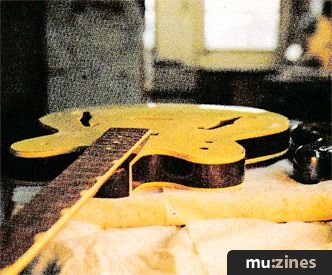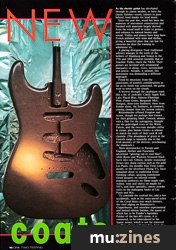Magazine Archive
Home -> Magazines -> Issues -> Articles in this issue -> View
New Coats | |
SprayingArticle from One Two Testing, July 1984 | |
why guitars go lovely colours

As the electric guitar has developed through its classic models, so have the classic finishes — exotic colours to pose behind, loud shades for loud music.
Since the year dot, wood has been the mainstay of instrument construction and finished with materials largely derived from the wood itself in order to protect and enhance its natural beauty and sound. Violins and pianos have long been French polished with stain and shellac, giving a beautiful gloss that can last for centuries (as does the training to administer it).
A glaring divergence from traditional sobriety emerges in the work of the luthiers of Hamburg and Venice in the 17th and 18th centuries (notably that of Joachim Tielke, check the V&A). Their guitars are lavished with ornamental marquetry in ebony, ivory, tortoiseshell and pewter. Already, it seemed, this instrument was demanding a different approach.
Freed by electricity from the constraints of acoustic considerations as far as its finish was concerned, the guitar went to town on the visuals.
A browse through the catalogues reads like a list of cocktails: Candy Apple Red, Lake Placid Blue, Salmon/Flamingo Pink, Foam Green, Burgundy Mist, Antigua, three-tone Sunburst; these from Fender alone, the Sunburst, as standard, coming cheaper than the custom colours.
Rickenbacker offered Fireglow and Azure, though are perhaps best known for their gleaming black. Gretsch, always with a flair for the outrageous, brought out the gold-edged ivory of the White Falcon, and the two-tone metallic coffee & cream, plus Smoke Green — a scheme to match the socks of their rock & roll clientele. (The abundance of green in the Gretsch range is reputedly due to the Irish ancestry of the director, proclaiming the shamrock.)
More downmarket in Europe and England, Hofner and Futurama advertised "glowing red or cool blue", while Burns and Watkins favoured black burst into red. Gibson, despite occasional forays into sharp exotica such as the gold Les Pauls, the metallic blue Trini Lopez model, or the silverburst Flying V's, have remained closer to traditional wood finishing values, spraying translucent tinted lacquers on selected woods: peardrop sunbursts on flame maple tops, walnut, wine and cherry on maple for 335's, and their speciality, cherry powder stain on the mahogany backs of Les Pauls and SGs.
To conclude the cocktail list, add a few accidentals, such as the crazy-paved ochre of the Coral Sitars (too much thinner), the vinyl edging on Danelectro's Copperbursts, and countless experimental and limited edition finishes, the queen of which has to be Fender's legendary Paisley of the late 60's (soon, it is rumoured, to be reintroduced in the Squier series), which is not far removed in effect, if not craftsmanship, from the marquetry of the Hamburg luthiers.
Joachim, you only needed the pick-ups and the wang bar...
The electric guitar is essentially a more active instrument than its classical predecessors and demands a tougher finish for its protection. The average Strad is likely to be treated with a touch more reverence than the average Strat.
The basic materials in use today are cellulose, polyester and, occasionally, acrylic, the latter on some acoustics and in specialised paints, but I won't dwell on it. If you have a guitar made within the last 15 years or so, the chances are (Gibsons excepted) that it is encased in polyester, the no-nonsense finish for a high-speed, uniform, industrial age.
It comes as a two-pack, with a catalyst added to the base material as it is used, so it "cures" chemically rather than by evaporation.

Its advantages: it can be poured on thick and fast from the gun for a rapid build, is processed within hours to total stability, and buffs and polishes easily. And it's very tough, though it does tend to shatter when clouted hard enough.
Now the disadvantages: in use it is highly unpleasant and, outside a professional environment, highly dangerous. I never pursued chemistry too far down its molecular avenues but creatures like iso-cyanates and peroxides suggest bad news.
To look at, I find it lifeless, its colours dull, trapping the light it should be reflecting. And if it eventually cracks, look up 'San Andreas Fault'. Which brings us to stripping it off for a refinish. As I said, it's tough. An Exocet is recommended if available; if not, a blowtorch, and plenty of time and fresh air. You may have guessed I'm not too keen on the stuff, but it is the standard medium for today's guitar production, and most people, punters and manufacturers alike, are satisfied with its results.
In dealing with cellulose. I'll begin with its disadvantages. To use, it's still fairly unpleasant — the hydro-carbons in the solvents are readily absorbed by inhalation and skin contact, causing a slowing of the brain cell. As a professional sniffer I don't quite see the attraction.

It cures, sinking as it does so, through evaporation of the solvents, and should be left ideally for four to six weeks at room temperature before polishing, less if you have baking facilities. But in the world of rock & roll where everything is needed yesterday, two weeks is sufficient if the guitar is treated with care. When knocked it dents rather than chips off, though the oil in certain hardwoods such as Rosewood, Koa and Sedua can make adhesion a problem if care is not taken to wash them out with solvent.
Though cellulose products are now largely synthesised, they were originally derived from the wood itself, and in conjunction with petrochemical solvents, seem a more natural choice than the alien polyester, being a part of the same process of growth and decay that put the trees there in the first place. This is, after all, a musical instrument we're talking about.
And the results: on clear and on translucent colour finishes, a glass-like transparency revealing the richness of the grain, and on solid colours and metallics, a depth and vibrancy. With age and oxidisation the colours mellow, bringing character to the guitar. A 1955 Gibson finished in polyester would not exude the same thoroughbred grace. An attractive "weatherchecking", more subtle than polyester's canyons, can develop. Severe temperature changes can bring this on prematurely. One of my own instruments aged 20 years on a three-week tour of Finland travelling at 30° below.

Many of the paints in use come courtesy of the Research and Development departments of the motor trade, as did Fender's originals so it's no problem to match to your Jag, Aston Martin, or Ford Anglia. The more exotic derive from the American custom car realms of fantasy. Candy Apple Red is a composite colour of a deep transparent red over a gold base, while the pearlescents are made from particles of crushed plastic tape (originally fish-scales), giving, on white, the effect of a polarised iceberg shifting hues as the angle of light moves. However, what can pass as a dazzling finish on an average car has to be further refined when reduced to the scale of a guitar.
I won't attempt to give a D.I.Y. guide to the process. Due to the toxic nature of the materials, the laws concerning their storage and the dust-free conditions required for a clean finish, your bed-sit is not the ideal environment for a respray. Even with a full airflow spray-booth with intake and extraction filters, the perverse ways of the Universe will always guide that floating speck onto the most visible part of the guitar.

In a brief outline, one word stands out — preparation. It's dusty and boring, but essential to the finished product. Even the smoothest grained woods such as alder, maple and poplar must be flattened to perfection with fillers and primers. Ash, much favoured in guitars for its combination of density and lightness, is a devil to fill due to the deep, fibrous grain of its spring growth, and here polyester can be a great help as a clear basecoat — very common on Fenders. Then follows spraying the colour, building a good thickness if it is not to be lacquered over. If the guitar is bound, the next stage is to scrape the binding clear with a steady hand and a sharp blade. (N.B. if stripping a bound guitar, beware as stripper eats it.) Proceed with about 12 coats of lacquer, the top of which will be cut back flat with wet & dry, then buffed and polished.

Complete restoration of a classic can obviously be a major decision for its owner, but is often more satisfactory than touch-in and repair, due to the difficulties in merging new material with old and matching to naturally aged colours. Part of the mystique, and the price tag, of vintage guitars can rest with the original finish, notably the '59 Les Paul Standard, which fetches astronomical prices in any condition, but this is not normally so crucial.
Many of the paint jobs are not so hot anyway on close inspection, and the main concern should be for the player to be comfortable with the feel and look of the guitar (within certain boundaries of taste, please). If the decision to respray is forced upon you by the inevitable head-break to your Les Paul or your Strat's windmill collision with a crash cymbal, fear not. By adding relevant tints to the lacquer with skill, the character of the guitar's age can be retained visually, the tints fading as the natural ageing process takes over.
More with this topic
String Attention |
Nails And Their Nature |
Workbench - CHECKA |
Sample & Hold Resurrection - what to do with your analog sample and hold once you've gone digital |
Workbench - Modifying The Midiverb |
Sourcing The Bottle - Valves |
Set It Up! |
 Instrument Repair |
Interconnect - Jackfile (Part 1) |
Resistance is Useless! - Impedance & Resistance Explained |
Roland Drumatix Modifications |
XLR Connectors Sounded Out |
Browse by Topic:
Maintenance / Repair / Modification
Publisher: One Two Testing - IPC Magazines Ltd, Northern & Shell Ltd.
The current copyright owner/s of this content may differ from the originally published copyright notice.
More details on copyright ownership...
Feature by Rick Biddulph
Help Support The Things You Love
mu:zines is the result of thousands of hours of effort, and will require many thousands more going forward to reach our goals of getting all this content online.
If you value this resource, you can support this project - it really helps!
Donations for November 2025
Issues donated this month: 0
New issues that have been donated or scanned for us this month.
Funds donated this month: £0.00
All donations and support are gratefully appreciated - thank you.
Magazines Needed - Can You Help?
Do you have any of these magazine issues?
If so, and you can donate, lend or scan them to help complete our archive, please get in touch via the Contribute page - thanks!















